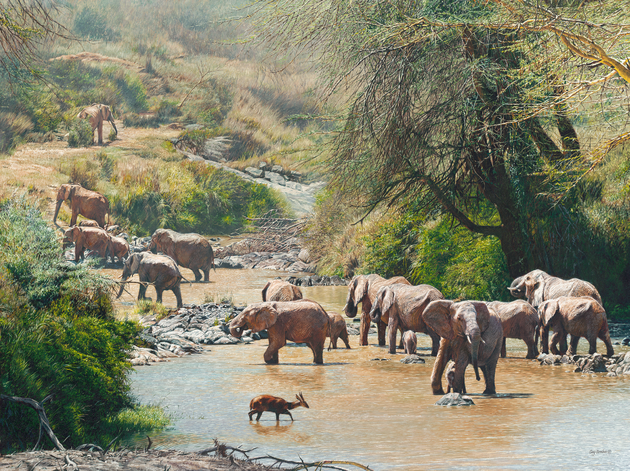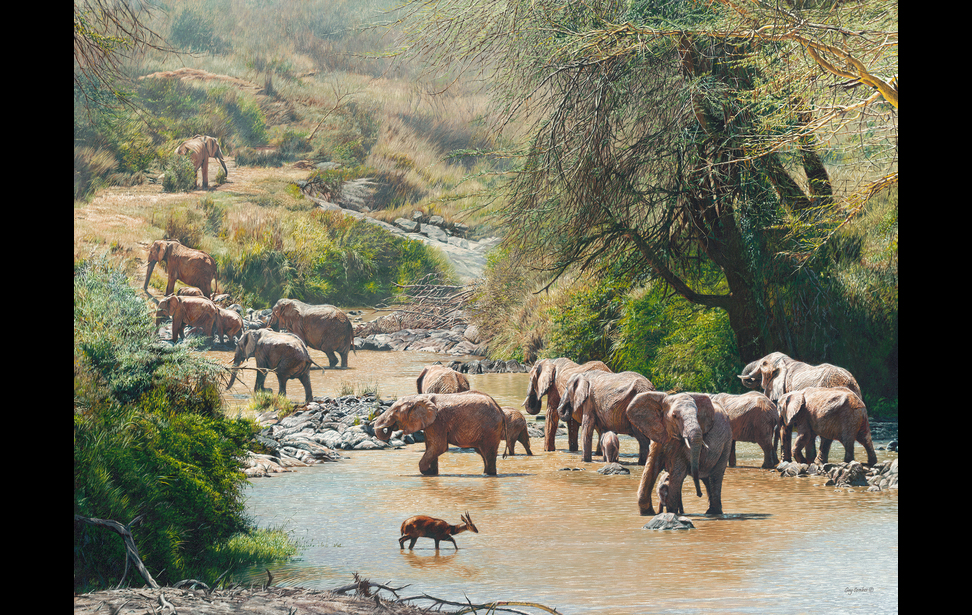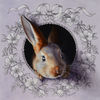SPOTLIGHT ARTIST Guy Combes
Thalo loves to promote artists and each month, we spotlight a memeber of our community!
This month we are pleased to have Guy Combes as the thalo Spotlight Artist.
Thalo Team: Can you give an "elevator pitch" of your work?
Guy Combes: I was born and raised in East Africa, and most of my paintings are a distillation of my experiences there of wildlife and wild places. I exhaustively collect and produce reference in the field and bring it together in images I strive to have represent moments in time that are both poetic and prosaic in equal measure.
TT: What is your artwork about and what do you want people to take from it?
GC: I would like people to look at my paintings and see, or be aware of more than just the subject. My motivation is to capture a moment in time, but one that alludes to a more multi-dimensional narrative about that moment, or subject. I no longer take any of my life's experiences for granted, and realize the privilege I have to be able to communicate them to others visually.

'Ancestral Oasis' - 48 x 36 - Oil on canvas - Elephants in river
TT: Which artists do you feel have influenced your art the most?
GC: Having immersed myself in art history at college, there are many to single out individually, and my influences are constantly changing. Right now I am stylistically driven by American tonalist landscape painters, including young living artists such as David Grossman. I am drawn to the philosophical motivation of Sargent in his landscapes, and similarly, the motivations of Wilhelm Kunhert's portrayals of Africa. I recently recharged with a visit to the museums of London and Paris, and I'm persuaded more than ever that this is an essential component to being motivated as an artist.
TT: Do you have a preferred method of presentation for your artwork and why? (Examples: workshops, gallery shows, Instagram, etc.)
GC: Social media is something I've never shied away from, and from the start, I've exploited it to its fullest potential. I am a communicator, and while paintings are a means to getting my ideas across, so are words and images in any form. Allowing an audience to view my creative process has been a very positive experience, both from peers and others. I also think it's absolutely essential that my work is able to be viewed in the flesh by the public, and curated in a way to make it accessible to all, which is why galleries are still so important.
TT: Out of all of your creations (or bodies of work) which one did/do you find the most cathartic in creating?
GC: So far, my largest painting, 'Passage of Promise', has been my most absorbing and life changing work. It is the culmination of 6 years of planning and one year on the easel, and is the realization of a goal to experience the process my father, who was also an artist, went through for his numerous large canvases. as expected, it was an emotional rollercoaster, and the feeling of accomplishment at the end is probably the greatest of my life so far.

'La Cazadora Nocturna' - 24 x 24 - Oil on Canvas - Jaguar
TT: When was your “Aha!” moment that led your work to where it is now?
GC: My father was a towering figure in the wildlife art world, and his shadow was considerably large. I always wanted to be creative, but the prospect of comparison loomed in my future. Any challenges where I failed to meet my own expectations were magnified, and I tried everything possible not to follow in his footsteps. Fortunately, for a year before he died unexpectedly, I was able to paint every day with him on the veranda at Soysambu. Many doubts were cast aside at this point, and the foundation was laid for my career. Nowadays I seek challenges rather than run from them.
TT: How has your work (or technique) changed over time?
GC: My technique has evolved in many ways that would not be immediately obvious from looking at my work. I have learned how to do certain things faster, leaving more time for consideration in others. My ideas for design and composition are always changing, and I'm somewhat nervous of being too formulaic. As I obsess over certain genres, like tonalism, it shows in my work, and I can only hope I never get to a point where there isn't something new to try.

'Passage of promise' - 84 x 56 - Oil on canvas
TT: How do you promote yourself and your art?
GC: I always try to keep my experiences fresh, and promote my work from the point of conception to completion. My collectors follow my travels on social media, and most of my work has sold to clients who have followed my experiences vicariously, or even physically with me on safari. Social media is a remarkable tool, but I always follow the lead of any galleries I work with. Their job is tough, and if they curate well, and know how to work with the right clients, their commission is always well deserved, and I have to respect their methods.
TT: Do you have any tips or advice for fellow artists based off of your experiences thus far?
GC: You may try to change your style or subject matter over time, but there will always be something that comes back to you again and again. If you can recognize what that is early on, and it's a limitless source of material, focus all your energy on it and make time for other stuff later on.
TT: What are you working on right now and why?
GC: I'm working on various collections for galleries and shows in 2018. A 'body of work' is the phrase of the moment these days, and it’s a great way for an audience to be reassured by consistency, and for the artist to expand their narrative. It's also a good marketing strategy to have several smaller works and a few large ones at different price points.
TT: What would you consider to be your "biggest achievement" with your work thus far?
GC: Through the auctioning of live quickdraws over the last year or so, I have been able to raise enough funds to implement measures to prevent predator/livestock conflict at Soysambu Conservancy, for which I am US Development Director. This has opened up an extra 48000 acres of habitat for lions in Kenya, where they are under constant threat.

'Incroyables' - 40 x 30 - Oil on canvas - Crowned cranes
TT: Do you take commissions? Why or why not?
GC: If a client approaches me to paint a subject they know I am familiar with, and they trust my ability to produce that vision without interference, I will be more than happy to take a commission. If a client comes with a laundry list of things they want in a painting, then I know that they have already created that painting in their mind, and are the most likely to be dissatisfied with the result. It's always an arrangement that requires different judgement based on the individuals every time.
TT: What do you do when you aren't working on artwork (hobbies, job, etc.)?
GC: Travel, safaris, lecturing, conservation work, marketing, running a business, photography, video production and research are all components of my artwork, so I'd be reluctant to call them hobbies, but they are mostly what I'm doing when I'm not at the easel. I do love to cook to unwind from painting, and was once a chef in another life.

'The Misanthrope' - 48 x 30 - Oil on canvas - cape buffalo in bamboo forest
TT: What is an area in your work that you feel weak in that you want to improve upon and how are you going to get there?
GC: The list is long, and I feel as though I am gradually addressing various things with each project. If I ever took a painting off the easel that I thought was perfect, then there would be little reason to continue, right?
TT: How do you overcome art blocks?
GC: This is an affliction that has mercifully eased off more and more for a couple of reasons. Firstly, I have many shows and commitments throughout the year, and I have to start planning for them pretty far ahead. this gives me time to percolate ideas while working on other projects, so that by the time I get to painting them, I am more confident about them. Secondly, I keep my reference fresh by going out in the field as much as possible. I still go back to experiences I had years ago, but I feel most energized after a safari or expedition.
TT: Where do you see your work taking you in the next 5-10 years?
GC: As I mentioned before, I would like to produce bodies of work with a unifying narrative. The logical step onward from that is to have a major one man show, and I'm courting venues that may be able to facilitate that 2-3 years from now. I 've had work in museums and galleries on 4 continents, but am yet to provide them with a consistent vision through a number of paintings.
TT: Is there something that you would like to share with us that we have not covered, that pertains to you and your work?
GC: As well as being an educator and promoter in the realm of conservation, I also give workshops on a regular basis every year. Some of these are independent and some are with institutions like the Arizona Sonora Desert Museum. My goal is to give a workshop in Kenya to established working artists who have not had the opportunity of tuition or exposure outside East Africa, and for this idea to develop into something that has international reach.
More of Guy Combes work at:
Webiste: www.guycombes.com
Facebook: https://www.facebook.com/guycombesartist/
Instagram: https://www.instagram.com/guy_combes_artist/?hl=en
Check out Guy's profile on thalo to read more: http://www.thalo.com/profile/view/bububuguy












